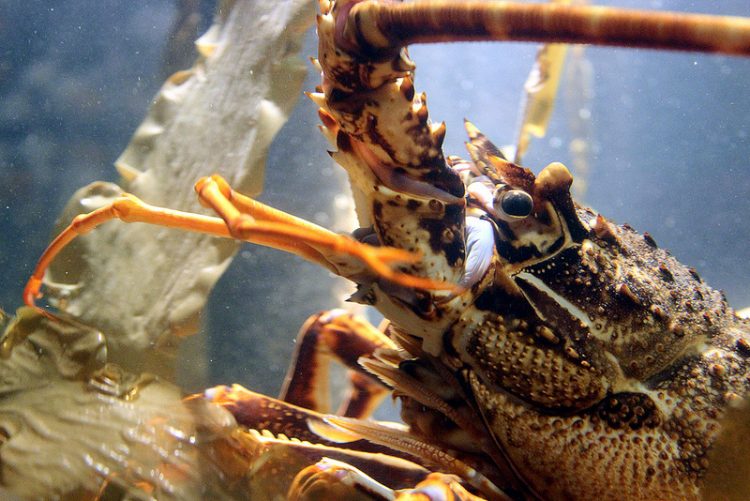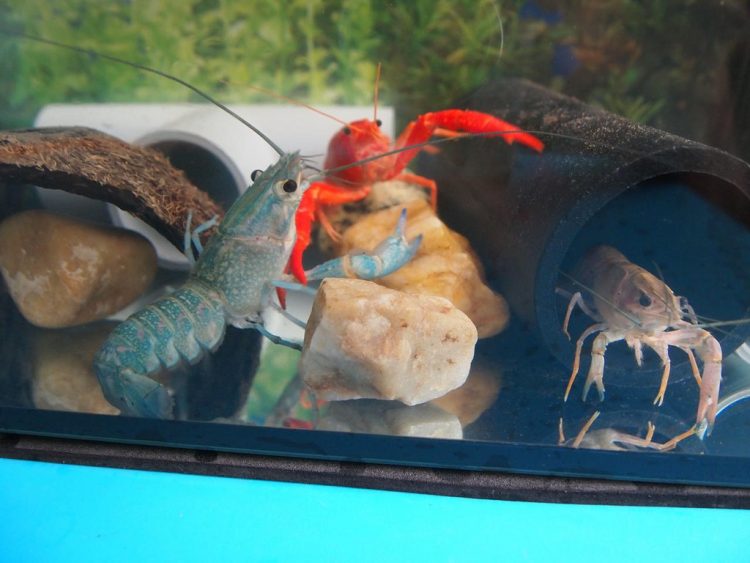[ad_1]
Photo: Abi Skipp
In the Northeast, lobsters are a familiar sight. You can find restaurants serving them with just about any meal even fast-food joints feature lobster dishes during the spring and summer months.
But some people choose to keep their lobsters out of the pot, and for good reason. These fascinating crustaceans can make surprisingly quirky pets and aren’t much more difficult to care for than other marine invertebrates.
Before you rush to scoop one out of the ocean, take a moment to learn what’s involved. Here’s what to consider if you’re thinking about keeping lobsters as pets.
- Lobsters as pets require careful planning: Research species differences, habitat needs, and behavior before setting up a tank.
- Tank setup is crucial: Provide at least 50 gallons of space per lobster, strong filtration, and stable water conditions.
- They are solitary animals: Most lobsters prefer living alone and may become aggressive toward tank mates.
- Diet variety keeps them healthy: Offer a mix of pellets, seafood, and plant material to mimic their natural diet.
- Lobsters can live for decades: With proper care, they can thrive for many years, making them a long-term commitment.
Lobsters as Pets: Choosing the Right Species
Not all lobsters thrive in home aquariums. If you’re serious about keeping lobsters as pets, choosing the right species is the first step toward a healthy, sustainable tank.
Popular Lobster Species for Home Tanks
Only a few types of lobsters adapt well to life outside the ocean. Among the most commonly kept are::
- Debelius lobster: Known for its striking purple hue and shy behavior.
- Feather star squat lobster: A small, reef-safe option that often hides among coral.
- Red lobster: A hardy freshwater variety that’s easier for beginners.
- Spiny lobster: Larger and more active, ideal for experienced marine keepers.
Each species comes with its own care needs some prefer cooler water, while others require more space or specific pH levels.
Key Considerations Before Bringing One Home
- Cold-water lobsters need chillers to maintain stable temperatures.
- Some species produce heavy waste, which demands robust filtration.
- Territorial behavior can lead to aggression toward tank mates.
In short, research is everything before you commit to keeping these fascinating crustaceans. Understanding their needs early helps prevent stress and health issues later on.
On the bright side, lobsters are low-maintenance companions; you’ll never need to walk them like a dog or worry about potty training accidents
Setting Up the Right Tank for Lobsters as Pets
A proper tank setup is essential for keeping lobsters as pets healthy and stress-free. These marine crustaceans can be territorial, messy, and surprisingly strong so your aquarium needs to be both spacious and stable.
If you’re new to aquarium keeping, check out our beginner guide on setting up your first tank for foundational tips before diving in.
How Much Space Does a Lobster Need?
Almost all lobsters need plenty of elbow room. In Saltwater Aquariums for Dummies, marine biologist Gregory Skomal explains that “if you place a lobster in your aquarium in the evening, by morning you will no longer recognize your aquarium.”
These feisty creatures will dig, rearrange rocks, and even challenge tank mates for space.
- Drs. Foster & Smith Aquatics recommends at least a 50-gallon tank for a single lobster.
- Larger or multiple lobsters require even more space to reduce aggression.
- Provide caves, rock crevices, and coral shelters so each lobster can claim territory.
If you’re considering more than one, use mesh partitions to divide the tank while maintaining consistent water temperature and pH levels.
Tank Conditions and Filtration
Because lobsters produce a lot of waste, a powerful filtration system is non-negotiable. Choose one rated for a tank size larger than yours.
Maintain these core conditions:
- Temperature: Cold-water species may need chillers to mimic their ocean habitat.
- Water quality: Keep ammonia and nitrate levels near zero.
- Substrate: Use fine sand or crushed coral for burrowing.
For beginners, our guide on raising betta fish offers simple lessons in water stability that apply to any aquatic setup.
Are Lobsters Aggressive in Captivity?
According to the Pictou-Antigonish Regional Library’s overview, lobsters rarely attack each other in the wild but in captivity, limited space and competition often bring out aggressive behavior.
Any smaller fish or shellfish in the same tank may quickly become part of your lobster’s dinner.
If you want multiple crustaceans, it’s safer to house them separately or use partitions to avoid injuries.
Do Lobsters Need Companionship?
Unlike social pets such as dogs or parrots, lobsters as pets are naturally solitary creatures. In the wild, they prefer to live alone, defending their chosen hiding spots with surprising intensity.
Lobsters Are Lone Occupants by Nature
Lobsters don’t crave company in fact, they usually avoid it. Even mating is a short-term interaction that lasts only a few days. Afterward, the fertilized female molts and retreats to a private shelter, while the male moves on to court others.
Marine researchers at the Lobster Institute note that these behaviors are deeply rooted in lobster biology and help minimize competition in their natural environment.
Trying to force companionship in captivity often leads to fights or injuries. If you plan to keep more than one lobster, separation is essential.
- Use mesh screens or tank dividers to share filtration but prevent direct contact.
- Watch for defensive postures, claw waving, or digging all signs of territorial stress.
- Provide plenty of space and hiding areas to reduce conflict.
When Sharing a Tank Works
Some smaller or less aggressive species like the feather star squat lobster can occasionally share an aquarium with compatible invertebrates if the setup includes abundant rockwork and caves.
Still, experts such as marine biologist Gregory Skomal in Saltwater Aquariums for Dummies caution that even mild-mannered lobsters can turn aggressive under stress.
If you want a more social aquarium experience, consider other peaceful aquatic species from our beginner aquarium setup guide
A Different Kind of Bond
While lobsters won’t form emotional attachments, they do exhibit unique behaviors worth observing from their nocturnal scavenging to how they defend burrows.
Keeping lobsters as pets is less about affection and more about appreciation: the rhythm of their movements, the quiet order of their environment, and the satisfaction of maintaining a thriving marine ecosystem.
This lobster has had enough of his old shell:
What Do Lobsters Eat?
Diet plays a huge role in keeping lobsters as pets healthy and active. Just like in the wild, these crustaceans are opportunistic feeders that enjoy a mix of proteins and vegetation.
What Lobsters Eat in the Wild
According to the University of Maine Lobster Institute, wild lobsters are omnivores they feed on small fish, clams, mussels, starfish, sea urchins, and even bits of plant matter they scavenge from the ocean floor.
This natural variety helps them build strong shells and maintain balanced nutrition. Mimicking this diversity in captivity is key to keeping your lobster thriving.
Feeding Lobsters in Captivity
When keeping lobsters as pets, try to replicate a balanced marine diet. Most hobbyists use a combination of:
- Sinking pellets or wafers designed for crustaceans.
- Fresh or frozen seafood such as shrimp, mussels, or small fish pieces.
- Vegetable-based supplements or algae wafers for added nutrients.
Feed sparingly, lobsters are messy eaters, and leftover food can quickly degrade water quality. Remove uneaten bits after a few hours to prevent ammonia spikes.
Feeding Schedule and Observation
Most lobsters are nocturnal and prefer to eat at night. Offer food once daily or every other day, depending on the species and tank size.
Keep an eye on their behavior:
- A healthy lobster will explore and forage after lights-out.
- Lethargy or refusal to eat can signal poor water conditions or stress.
Recording feeding habits over time can help you adjust portion sizes and identify early signs of illness.
How Long Do Lobsters Live as Pets?
One of the most fascinating things about lobsters as pets is their potential longevity. These creatures can live for decades and in the wild, some have even reached legendary ages.
Lifespan in the Wild
In their natural ocean habitats, lobsters can live well beyond 50 years, and researchers have found evidence of some surviving for over a century. Their secret lies in a slow metabolism and the ability to continually regenerate cells through molting.
One of the most famous examples is George, a 20-pound lobster believed to be about 140 years old, who was rescued from a restaurant tank and released back into the ocean. Stories like George’s highlight just how resilient and long-lived these creatures can be when left in their natural environment.
Lifespan in Captivity
In home aquariums, lobsters typically live 5 to 20 years, depending on water quality, diet, and overall care. Since aquariums restrict their space and natural behaviors, proper maintenance makes all the difference.
To help your pet lobster thrive:
- Keep water parameters stable and perform regular partial water changes.
- Use efficient filtration to control ammonia and maintain oxygen levels.
- Offer a balanced diet that mimics natural seafood and algae sources.
When cared for correctly, lobsters as pets can live surprisingly long lives outlasting many common aquarium species.
A Long-Term Commitment
Keeping lobsters as pets isn’t just a novelty it’s a long-term commitment. With good husbandry and consistent tank conditions, they can be fascinating companions for years to come.
Before bringing one home, be sure you’re ready for the upkeep, observation, and patience required to give these marine invertebrates a comfortable, lasting home.
Research Is Key Before Keeping Lobsters as Pets
Bringing home a lobster might sound simple, but responsible aquarists know that research is the foundation of success. Keeping lobsters as pets requires understanding their species-specific needs from temperature control to diet and tank size long before you fill the aquarium.
Why Research Matters
No two lobster species are the same. Some thrive in tropical saltwater tanks, while others need colder, oxygen-rich conditions to survive. Learning these differences early helps prevent stress, disease, and aggression.
Take time to read marine care guides, visit public aquariums, and talk with experienced hobbyists or marine biologists. Staff members at reputable aquarium stores can also help you find equipment suited to your chosen species.
For further reading, reference educational resources like the University of Maine Lobster Institute, which provides accessible science-based information about lobster biology and care.
Setting Realistic Expectations
Caring for lobsters means committing to long-term maintenance rather than companionship. Unlike mammals, they won’t bond or show affection, but they do reward patience with fascinating behavior and surprising intelligence.
Before starting, make sure you have:
- The space for a large, stable tank.
- The budget for equipment such as chillers and filters.
- The time for research, observation, and upkeep.
As with any exotic pet, your goal should always be to replicate natural conditions as closely as possible. That’s the key to keeping lobsters as pets healthy, active, and stress-free.
Frequently Asked Questions (FAQ)
How long can a lobster live in captivity?
Lobsters can live 5 to 20 years in captivity, depending on water quality, diet, and overall care.
Are lobsters hard to keep?
Lobsters are moderately challenging to keep, as they need stable water conditions, plenty of space, and specialized equipment.
Are lobsters harmless to humans?
Generally yes, lobsters are harmless to humans, though they can pinch if handled carelessly.
[ad_2]




